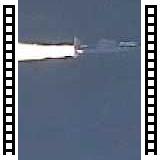 | Getting GOCE to the launch pad (2011-06-20)      The Gravity Field and Steady-State Ocean Circulation Explorer (GOCE) is an ESA satellite that was launched on March 17, 2009.
|
 | GOCE liftoff (2011-06-20)      The Gravity Field and Steady-State Ocean Circulation Explorer (GOCE) is an ESA satellite that was launched on March 17, 2009.
|
 | Ham the Chimp Goes to Space! (2011-06-20)      On January 31, 1961 NASA launched a Mercury Redstone rocket with Ham the chimpanzee on board. The capsule traveled 157 miles before splashing down in the Atlantic Ocean. news.bbc.co.uk en.wikipedia.org Ham (July 1956 January 19, 1983), also known as Ham the Chimp and Ham the Astrochimp, was the first hominid launched into outer space. Ham's name is an acronym for the lab that prepared him for his historic mission - the Holloman Aerospace Medical Center, located at Holloman Air Force Base in New Mexico.
|
 | Space Shuttle Discovery Blasts Off -- in HD!! (2011-06-20)      Discovery lifts off from Kennedy Space Center on the STS-128 mission to deliver supplies and equipment to the International Space Station.
|
 | X-43A Goes 7000 MPH - Getting Ready for Mach 10 (2011-05-29)      www.nasa.gov X-43A Raises the Bar to Mach 9.6 Guinness World Records recognized NASA's X-43A scramjet with a new world speed record for a jet-powered aircraft - Mach 9.6, or nearly 7000 mph. The X-43A set the new mark and broke its own world record on its third and final flight on Nov. 16, 2004. In March 2004, the X-43A set the previous record of Mach 6.8 (nearly 5000 mph). The fastest air-breathing, manned vehicle, the US Air Force SR-71, achieved slightly more than Mach 3.2. The X-43A more than doubled, then tripled, the top speed of the jet-powered SR-71. en.wikipedia.org The X-43 is an unmanned experimental hypersonic aircraft design with multiple planned scale variations meant to test different aspects of hypersonic flight. It is part of NASA's Hyper-X program. A winged booster rocket with the X-43 itself at the tip, called a "stack", is launched from a carrier plane. After the booster rocket (a modified first stage of the Pegasus rocket) brings the stack to the target speed and altitude, it is discarded, and the X-43 flies free using its own engine, a scramjet.
|
 | X-43A Goes 7000 MPH - Launch from the Mothership (2011-05-29)      www.nasa.gov X-43A Raises the Bar to Mach 9.6 Guinness World Records recognized NASA's X-43A scramjet with a new world speed record for a jet-powered aircraft - Mach 9.6, or nearly 7000 mph. The X-43A set the new mark and broke its own world record on its third and final flight on Nov. 16, 2004. In March 2004, the X-43A set the previous record of Mach 6.8 (nearly 5000 mph). The fastest air-breathing, manned vehicle, the US Air Force SR-71, achieved slightly more than Mach 3.2. The X-43A more than doubled, then tripled, the top speed of the jet-powered SR-71. en.wikipedia.org The X-43 is an unmanned experimental hypersonic aircraft design with multiple planned scale variations meant to test different aspects of hypersonic flight. It is part of NASA's Hyper-X program. A winged booster rocket with the X-43 itself at the tip, called a "stack", is launched from a carrier plane. After the booster rocket (a modified first stage of the Pegasus rocket) brings the stack to the target speed and altitude, it is discarded, and the X-43 flies free using its own engine, a scramjet.
|

















































